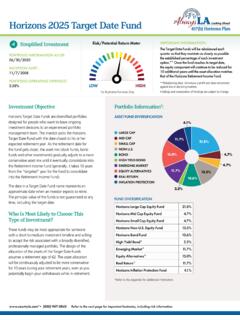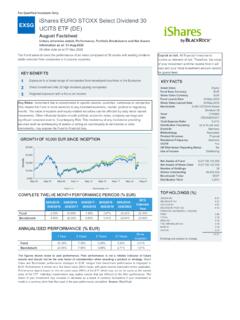Transcription of Bloomberg: Getting Started - Jan Röman
1 1 bloomberg : Getting Started TABLE OF CONTENTS What do the bloomberg terminals look like? 2 Log On/Off 2 Green Keys 3 MOST HELPFUL KEYS 4 bloomberg is menu driven 8 Yellow Keys 8 Useful tips 8 Learn more about bloomberg 9 bloomberg News 10 System Levels 10 Searching bloomberg 10 Appendix 13 EQUITY 13 Warrants, Futures and Options 15 Fundamental Analysis 17 M&A Analysis 18 FIXED INCOME 18 Swaps 21 FI Futures and Options 22 Repo Analysis 23 Derivatives, Convertibles and Asset Swaps 24 Money Markets 25 Structured Finance Analytics 26 High Yield/Syndicated Loans/Distressed Research 27 Municipal Bonds 28 2 This guide is intended to: Provide a brief introduction to the bloomberg system, including the custom bloomberg keyboard and function keys.
2 Help you gain an understanding of how information is organized in the bloomberg system for easy retrieval. What do the bloomberg terminals look like? Monitors: bloomberg has two flat-panel monitors, which allows you to view two displays simultaneously. The active screen shows a blue flashing cursor. To switch between the panels, click on the inactive panel to activate it or press the <PANEL> key. Keyboard: bloomberg has a colored keypad (Please go to bloomberg keyboard page ( ) for an image of the keyboard.) The yellow function keys across the top represent different markets- each will bring up a similar main menu for that market.
3 The green keys are action keys that execute your commands. In this guide, keywords, commands and mnemonics are used interchangeably. Log On/Off: Log on to bloomberg using one of the following two methods. Method 1 Press <CONN DFLT> Enter Username and Password. Press <GO> Method 2 Enter L <GO> Enter Username and Password. Press <GO> Log off of bloomberg using the following: Press <CONN DFLT> 3 Here is a typical Login screen: <CANCEL> To reset a screen or cancel a current command Green Keys The Green keys are action keys and allow you to move throughout the system. <GO> : To access a particular screen, one might enter some keyword(s) and then press <GO>, or press some key and then press <GO>, or use a combination of keys and keywords and then press <GO>, or click on the highlighted item on the screen, or in some special cases, just press certain keys, such as the <Menu>, <Page Fwd>, <Page Back>, etc.
4 The use of the <GO> key is analogous to the use of the Enter key in other Windows applications. Note: Keywords are always entered in the top left corner of the screen. If you want to enter keywords, and if the cursor is not flashing on the top left corner, click on the top left corner and make sure that the cursor is flashing there. If it doesn t work in some cases, press <HOME>. You can then enter keywords. <MENU> : to go back to a previous menu or screen, this is going to be one of the most frequently used keys. 4 <PAGE FWD> and <PAGE BACK> : The top right corner of any screen will show the number of pages for that particular screen topic.
5 Use <PAGE FWD> and <PAGE BACK> to go forward and backwards through these pages. Use the <MENU> key to go to the most immediate menu from which the current screen is referenced. <NEWS> To access bloomberg s 24-hr global online news service <PRINT> To print any screen. To print a multi-page report, type the # of pages to print, then press the <PRINT> key. For example, to print a 5-page report, press 5 <PRINT>. Type 9 <GO> to print the whole report. <PANEL> Switch bloomberg screens <CMND> Press each time to see previous keywords you entered You can also type LAST <GO> to see last eight commands you entered.
6 MOST HELPFUL KEYS <HELP> and <SEARCH> are two of the most helpful keys in bloomberg , especially for people in learning process. <HELP> : This key provides 3 important functions: 1. <HELP> as Screen Help: To understand what a given keyword or screen contains, just press <HELP> once to define terminology, formulas and applications for that screen. 5 Example. Start with the following screen by typing MOST <GO>. Note that the command will appear on the top right corner of the screen. If you press <HELP> once, you get the following screen. 6 Typical HELP screen includes function of the command, how to use it, screen descriptions, shortcuts and calculations.
7 There are also FAQs in HELP for complicated commands. I personally think bloomberg HELP information is very specific and effective. Click <MENU> or press the <MENU> key to go back to the previous MOST screen. Press <HELP> twice to chat with bloomberg s LIVE customer service. When the word Message is flashing at the top of the bloomberg screen, it means a representative has responded to your question in email. To view the reply, type HDSK <GO>. To displays the entire message functions available on the bloomberg , type MSGM <GO>. <SEARCH> key or SEARCH <GO> OR type the words you want to search and then press the <HELP> key OR type the words you want to search in the amber search box on the top of screen will get you to the same search screen.
8 In our example, I searched for mutual fund . 7 The above HELP screen shows that, there is a certain number of references under some categories indicated by a number in white, you can now click on one of the categories or type the number associated with the category then press the <GO> key. I clicked 11) FUNDS. By entering more keywords in the amber search box below right after current keywords, and/or using Filter on the right side to narrow down the search. 8 bloomberg is menu driven Type MAIN <GO> to go to main menu for the bloomberg Professional Service, then go to sections that are of your interest.
9 Yellow Keys The yellow keys represent market sectors government, corporate, mortgage, money market, municipals, preferred, equity, commodities, index, currencies and client. <GOVT> Securities issued by national governments and securities by quasi-governmental agencies <CORP> Information regarding corporate bonds <MTGE> Information regarding mortgages and collaterized mortgage obligations <M-MKT> Money market information <MUNI> Trading, descriptive and settlement information regarding municipal and state bonds <PFD> Preferred market includes public and private security types, including: fixed, floating, variable rate, zero-coupon, convertibles, and warrants.
10 <EQUITY> Complete information on Equities <CMDTY> Commodities and their associated futures and options <INDEX> Generic interest rates as well as economic indices, such as the Consumer Price Index (CPI). <CRNCY> Foreign currency database <CLIENT> Create and analyze portfolios Press the <Yellow Key> for the market sector and then <Go> for a menu of general analytics which can be performed on that specific market sector. This doesn t require you to know any commands, but this is not an efficient way to use bloomberg . It is better to learn the commands through using those menus in the beginning. Every financial instrument or index in bloomberg can be accessed by using a ticker symbol for that financial instrument or index followed by a yellow market sector key [ticker] <yellow key>.






